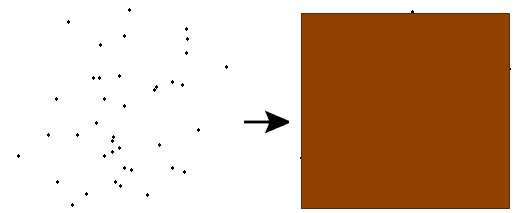Takes a set of point, linear, polygonal, and/or aggregate features, and creates a two-dimensional bounding box, which contains all features. The bounding box is defined as the minimum enclosing rectangle for all input features. The minimum rectangle is such that all sides of the rectangle are parallel to the x axis and the y axis.
The input features may be partitioned into groups based on attribute values using the Group By parameter, and one bounding box feature is output for each group. If the Group By parameter is not specified, then all input features will be processed together and a single bounding box will be output. If a given bounding box has zero area, it will become a line or a point.
Parameters
Transformer
One bounding box feature is output for each unique combination of values of the attributes specified in the Group By parameter. The bounding box is the smallest rectangle that contains all the features that were members of the group. If Group By attributes are not specified, a single feature is output that represents the bounding box of all the features.
Note: How parallel processing works with FME: see About Parallel Processing for detailed information.
This parameter determines whether or not the transformer should perform the work across parallel processes. If it is enabled, a process will be launched for each group specified by the Group By parameter.
Parallel Processing Levels
For example, on a quad-core machine, minimal parallelism will result in two simultaneous FME processes. Extreme parallelism on an 8-core machine would result in 16 simultaneous processes.
You can experiment with this feature and view the information in the Windows Task Manager and the Workbench Log window.
No: This is the default behavior. Processing will only occur in this transformer once all input is present.
By Group: This transformer will process input groups in order. Changes on the value of the Group By parameter on the input stream will trigger batch processing on the currently accumulating group. This will improve overall speed if groups are large/complex, but could cause undesired behavior if input groups are not truly ordered.
Parameters
The Topfer index is a rule of thumb that dictates the number of source and destination features a generalized map should maintain. This parameter defaults to No. If you choose Yes, the Topfer Index Attribute and Source and Destination Scale parameters are enabled.
If you set the Calculate Topfer Index parameter to Yes, an attribute containing the Topfer index will be attached to both the BoundingBox and Original output features.
The following formulas are used to calculate the scale factors of the source and destination data:
N-destination = N-source*((S-source/S-destination)**0.5)
where:
N-destination = number of features output
N-source = number of features in input
S-source = scale of source map
S-destination = scale of destination map
Example

Editing Transformer Parameters
Using a set of menu options, transformer parameters can be assigned by referencing other elements in the workspace. More advanced functions, such as an advanced editor and an arithmetic editor, are also available in some transformers. To access a menu of these options, click  beside the applicable parameter. For more information, see Transformer Parameter Menu Options.
beside the applicable parameter. For more information, see Transformer Parameter Menu Options.
Transformer Categories
To retrieve the bounds of a feature into attributes, use the BoundsExtractor.
To replace a feature with its bounding box, use the BoundingBoxReplacer.
Search FME Knowledge Center
Search for samples and information about this transformer on the FME Knowledge Center.
Tags Keywords: MBR "minimum bounding rectangle" neatline envelope "Topfer index"